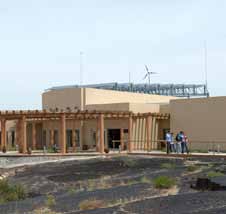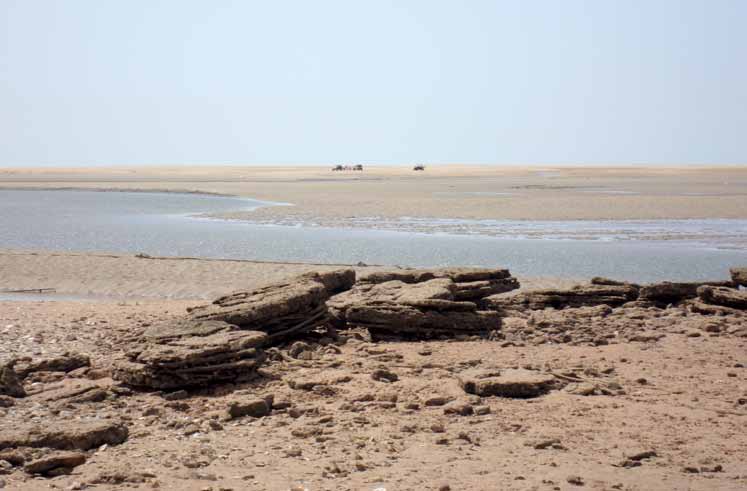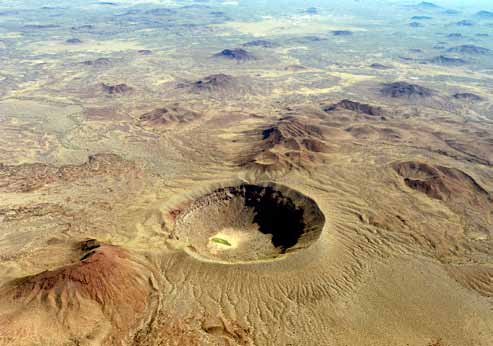By Marco Antonio Santiago León*
Puerto Peñasco, a fishing community founded in 1927, has also become a desirable tourist destination. But it could become a desert dominated by enormous sand dunes, like the Sahara, if the earth’s temperature rises by 11° degrees Fahrenheit.
Based on scientific research, we know that with such a change, the flora and fauna could be wiped out and life would be completely different where temperatures could exceed 140° degrees Fahrenheit.
Researchers and experts also warn that avoiding global warming requires both individual efforts and investments by governments and businesses.
 The Schuk Toak Visitor's Center is a model for building design and appropriate use of locally available materials.
The Schuk Toak Visitor's Center is a model for building design and appropriate use of locally available materials.
(Photo: Ernesto Bolado Martínez)PuertoPeñasco
14
 Puerto Penasco is part of the Upper Gulf of California and Colorado River Delta Protected Area (Photo: Marco Antonio De Santiago León)
Puerto Penasco is part of the Upper Gulf of California and Colorado River Delta Protected Area (Photo: Marco Antonio De Santiago León)
Confronting two challenges:
Climate change, sustainability
By engaging in activities that damage the environment today, the community is harmed in the long term. On the other hand, sustainability consists of satisfying today’s necessities without sacrificing the needs of future generations. This means a balance between progress and nature.
An example is the harvesting of wood from a forest. If too many trees are cut, the forest disappears; if the wood is harvested below a certain limit, wood will always be available. The first case contributes to greenhouse effects with the subsequent increase in local and global temperatures. In the latter scenario, the exploitation of the forest is sustainable.
Other examples of resources that could be sustainable, or could cease to be so depending on the rate they’re used, are water, fertile soil, and fisheries.
To promote sustainability and reduce climate change, individuals can: reduce, reuse, recycle, reforest and save useful materials, among other efforts. One can turn off lights, save water, plant trees and maintain vehicles in good working order.
that will be devoted to sustainable development.
Homo sapiens have only inhabited the earth for around 40,000 years and we are the only animal species capable of responding to the threat of global climate change. What is needed is a response by us that will result in the care, protection and conservation of our planet’s resources.
*Student, Center for Marine Technology Studies (CETMar), No. 14
 The El Pinacate y Gran desierto de Altar Biosphere Reserve is one of the world's unique places that offers many attractions for tourists.
The El Pinacate y Gran desierto de Altar Biosphere Reserve is one of the world's unique places that offers many attractions for tourists.
(Photo: Ernesto Bolado Martínez)
It was built at a slightly higher cost than if it were built using conventional materials, but it’s hoped that in the long run it will reap savings due to its self-sufficient use of solar power. The center also promotes tourism and the protection of the flora and fauna of the volcanic region known as El Pinacate.
Today, one wonders if the huge investments in hotels, which began to roll in as early as 1990, will benefit the area in a manner
Governments are in a position to invest in the conversion from fossil fuels to renewable energy, such as photovoltaic cells, and wind, solar and hydroelectric energy.
In Puerto Peñasco, an example of this kind of investment in sustainability is the visitor’s center at Pinacate called Schuk Toak, which means “sacred mountain” in the language of the indigenous Tohono O'odham people.
 The Schuk Toak Visitor's Center is a model for building design and appropriate use of locally available materials.
The Schuk Toak Visitor's Center is a model for building design and appropriate use of locally available materials. The Schuk Toak Visitor's Center is a model for building design and appropriate use of locally available materials.
The Schuk Toak Visitor's Center is a model for building design and appropriate use of locally available materials. Puerto Penasco is part of the Upper Gulf of California and Colorado River Delta Protected Area (Photo: Marco Antonio De Santiago León)
Puerto Penasco is part of the Upper Gulf of California and Colorado River Delta Protected Area (Photo: Marco Antonio De Santiago León) The El Pinacate y Gran desierto de Altar Biosphere Reserve is one of the world's unique places that offers many attractions for tourists.
The El Pinacate y Gran desierto de Altar Biosphere Reserve is one of the world's unique places that offers many attractions for tourists.